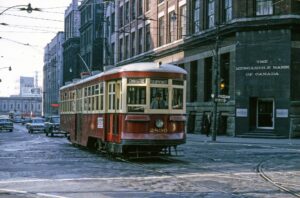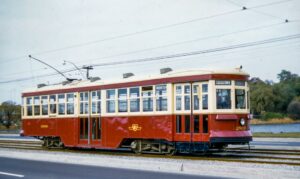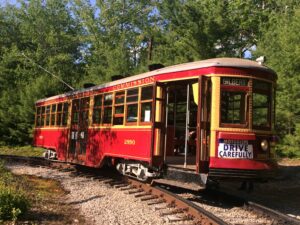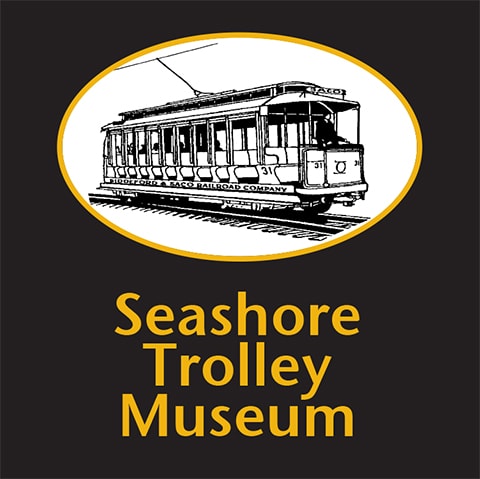
No. 2890 in service on August 27, 1962; John F. Bromley
Operating History: In 1914, Cleveland, OH Transit Commissioner Peter Witt designed a streetcar for passengers to enter at the front door and exit at a center door, paying when they passed the conductor who sat just ahead of the center door, saving time at stops. This design became known as a “Peter Witt” car and became popular in Cleveland and elsewhere. The Toronto Transportation Commission (TTC) took over the Toronto Railway Company in 1921 and undertook a major fleet renewal. The new fleet consisted of 350 “Peter Witt” motor cars and 225 matching trailers. There were two varieties, “Large Witts” able to haul trailers, and “Small Witts” which were lighter and one window shorter. In 1938, the TTC started buying PCC streetcars to replace older Toronto Railways equipment, but most of the “Peter Witt” cars continued running until a major streetcar line was replaced with the Yonge Street subway in 1954. Some “Peter Witts” remained in regular service until 1963. As late as the 1980s, there were one large and two smalls plying Toronto’s streets as “Tour Trams.” In 1954, the Toronto Transportation Commission was renamed the Toronto Transit Commission. By the 1960s, most U.S. and Canadian cities had abandoned their streetcar systems, leaving Toronto the largest streetcar operator in North America.
As part of the TTC’s fleet renewal, in 1923 Ottawa Car Co. built 50 “Small Witt” cars with even numbers from 2800 to 2898. (The TTC assigned even numbers to motor cars and odd numbers to trailer cars.) TTC converted No. 2890 to one-man operation in 1936. The TTC retired No. 2890 from regular service in 1960. The TTC overhauled the car and ran it in charter service until 1963.
Museum Ownership: When TTC was retiring its pre-PCC streetcars in the 1960s, Seashore had acquired several Montreal cars and decided not to seek a Toronto car. However, in 1969, Seashore had acquired a Canadian interurban car, Lake Erie & Northern No. 797, from the failed Rail City Museum. No. 797 sat untouched at Seashore for decades. In the meantime, the Ontario Electric Railway Association, operating as the Halton County Radial Railway, had acquired several Toronto “Peter Witt” cars, including No. 2890 donated by TTC in 1963. The Halton County Radial Railway offered to trade their TTC “Small Witt” No. 2890 for Seashore’s No. 797. Seashore desired the Toronto car because Toronto was the most significant North American streetcar system not yet represented in the museum’s collection. The two museums made the exchange in 1999. The Halton museum had done substantial restoration on No. 2890, and the car came to Seashore in fair condition. Seashore regauged the trucks from Toronto gauge (4’ 10-3/4”) to standard. No. 2890 joined two other “Peter Witt” cars at Seashore: New York State Railways No. 1213 and Baltimore No. 6144. Several other Toronto “Peter Witt” cars are preserved at Canadian museums and at the Shore Line Trolley Museum in Connecticut.
Current Condition: No. 2890 recently finished a restoration and is on display for the public to enjoy.

No. 2890 in service on October 10, 1957; J. Willian Hood.

No. 2890 at Seashore Trolley Museum, 2019; STM collection.
 |
 |
 |
